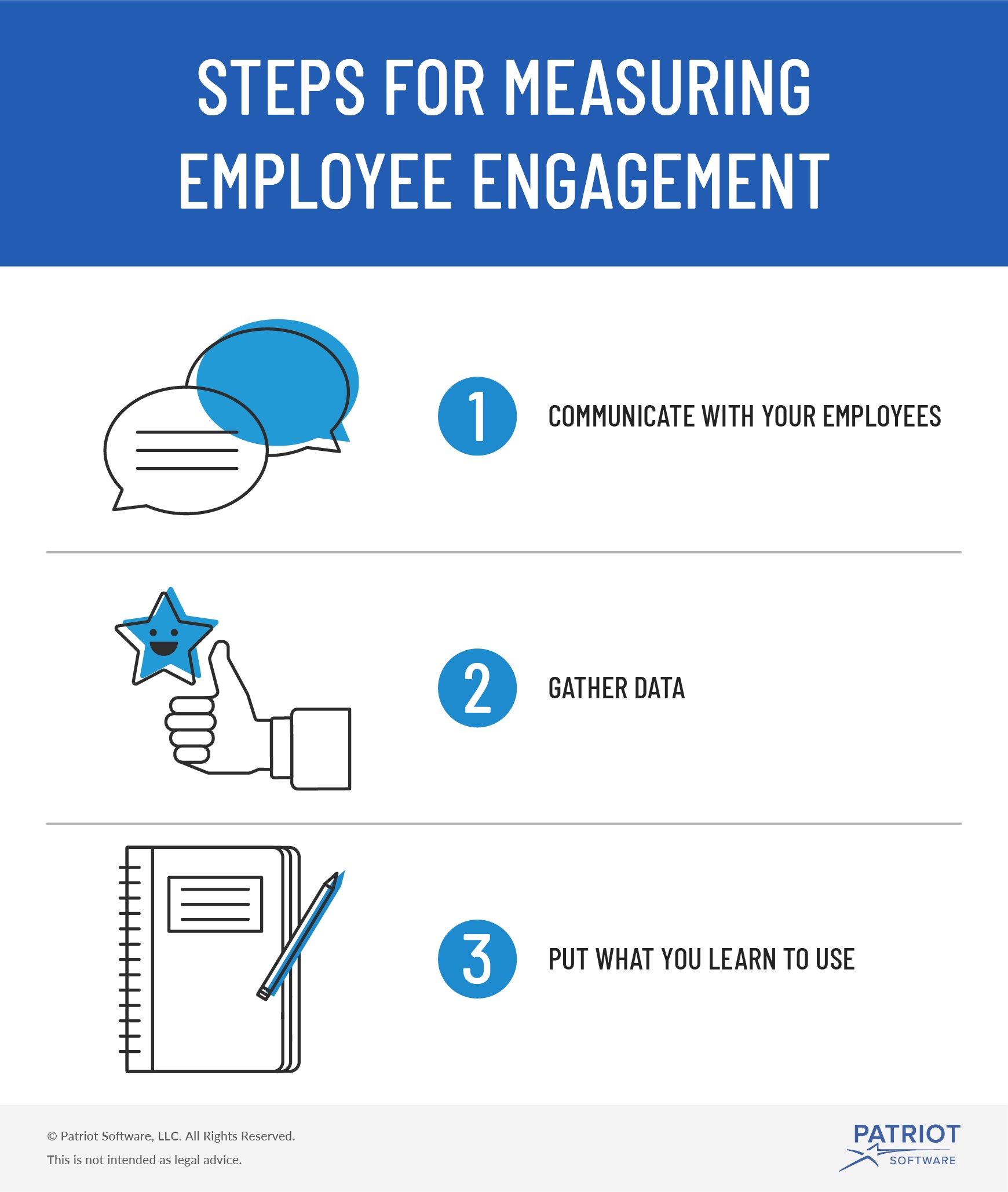“Wah wah” (think Charlie Brown’s teacher) is something you don’t want going on in your employees’ heads when they’re working. But as time goes by, your employees might start losing interest in their work. If you want to figure out where your employees are at, try measuring employee engagement.
Steps for measuring employee engagement
To measure engagement, you need a plan. Engagement is a pretty difficult thing to measure because so much goes into it—employee retention, ownership, satisfaction, drive, etc.
So if you want to measure engagement, you need to use both qualitative and quantitative research methods. Let’s take a step back and define these:
- Quantitative: Numerical data (e.g., percentages)
- Qualitative: Non-numerical data (e.g., opinions)
You need to gather both employee opinions and hard data to measure engagement. Use the three steps below to get started.

1. Get it straight from the horse’s mouth
If you want to know how engaged your employees are, the first thing you should do is ask them. Talk with your employees to get a first-hand feel of their job attitudes. This is the kind of qualitative information critical for measuring employee engagement.
There are a few ways you can gauge employee engagement, including:
- One-on-ones
- Performance reviews for small business
- Department meetings
- Committees
- Surveys
Regularly communicate with your employees to figure out how engaged they are in their positions. Ask questions to find out what areas need improvement. And of course, find out what areas they’re happy with.
On the importance of checking in with employees, Rod P. Githens, Ph.D., Associate Dean and Associate Professor at University of the Pacific, said:
We know that employee engagement levels vary for folks depending on what’s going on both inside and outside of work. Checking in with employees through frequent 1:1 meetings is important. Not just checking in how projects are going on, but asking genuine questions about how someone’s work is going overall and making sure that the person knows that you’re not just looking for a positive response. Managers have to create the space for honest answers from employees, in order to have a true discussion.”
Create a schedule so you can regularly meet with employees. For example, you might have weekly one-on-ones and department meetings, monthly committee meetings and employee engagement surveys, and semi-annual performance reviews.
John Rampton, Founder and CEO of Calendar, believes regular performance reviews are the key to assessing engagement and boosting productivity:
It’s essential to have employee engagement because it affects the overall productivity of your company. I hold quarterly performance reviews with each of my employees every year. It is so important to have a dedicated meeting to evaluate and gain an understanding of the engagement of each of the people on your team. Having a quarterly meeting gives leadership insight into where their teammates are and where they need to be in order to be set up for success in the future.”
Some employee engagement questions you can ask both in-person and on paper include:
- On a scale of 1-10 (with 10 being the highest), how much do you enjoy your job?
- Do you feel recognized at work? (Always, Sometimes, Neutral, Not Often, Never)
- Do you agree with this statement? “I know how my work relates to the company’s overall goals.”
- What can we improve on?
Surveys can be a great way to find out how your top-performing employees are feeling, too. Dmytro Okunyev, Founder of Chanty, says:
We use surveys to find out about our employees’ engagement levels, since they’ve worked the best for us. We’ve found that even high-performing employees can feel disengaged at work and through time, they will either burn out or quit. That’s why we measure engagement, to make sure that employees are happy to work for us and that they are mentally in the right place. If things seem off after an employee engagement survey, we suggest that the employee takes some paid time off.”
When talking with your employees, be sure to take notes. That way, you can easily categorize and assign values. Hang onto survey responses, too.
Compare past and present responses to determine if employee engagement is decreasing, increasing, or stagnant.
2. Gather data
You must look beyond what your employees say and analyze what they do, too. Gathering data can help you quantify engagement.
Some employee engagement measurement tools include:
- Absenteeism rate
- Employee net promoter score
- Turnover rates
Absenteeism rate
Absenteeism is when an employee continually misses work. Employees might be absent for both legitimate (e.g., sick) and non-legitimate (e.g., burnout and disengagement) reasons.
Calculating your business’s absenteeism can give you insight into workplace engagement. But because absenteeism can be due to a number of reasons, you shouldn’t put all your stock into your rate.
To find your business’s absenteeism rate, use the following formula:
Absenteeism Rate = (Average # Employees X Missed Workdays) / (Average # Employees X Total Workdays)
You can calculate your absenteeism rate at any frequency you’d like, such as weekly, monthly, or annually. A high absenteeism rate might indicate your employees are disengaged from their work.
Employee net promoter score
An employee net promoter score (eNPS) measures how likely your worker would recommend your business to a family member or friend.
Net promoter scores are great indicators of engagement. Why? Because engaged employees are typically more willing to promote the business they work for than disengaged employees.
To find eNPS, you must first ask employees how likely they are to recommend your business. Then, put your employees’ responses together to find your business’s NPS.
NPS Question: On a scale of 1-10, how likely are you to recommend Company XYZ to your family and friends?
Employees who give a 9 or 10 rating are considered “promoters.” Employees who give a rating of 0-6 are considered “detractors.” If your employees give a score of 7 or 8, they are considered passive. Do not do anything with passive employees.
Next, find the percentage of employees who are promoters and detractors. Use the following formulas to get started:
- % of Promoters = # of Promoters / Total Responses
- % of Detractors = # of Detractors / Total Responses
Lastly, use the NPS formula as a measure of employee engagement:
NPS = % of Promoters – % of Detractors
NPS can range from -100 to 100. The higher your NPS, the more likely your employees would recommend your business. Scores between 0 – 50 are typically considered good. Scores between 50 – 100 are generally considered excellent.
Example
Because NPS can be a little tricky, let’s look at a simple example. You have two employees. One employee gives a 9 rating (promoter) and the other gives a 5 rating (demoter). First, find the promoter and detractor percentages:
% of Promoters = 1 / 2
% of Detractors = 1 / 2
You have a promoter percentage of 50% and a detractor percentage of 50%. Next, find your NPS:
NPS = 50% – 50%
NPS = 0
Your business’s NPS is 0 on a scale of -100 to 100.
Turnover rates
Because disengagement can lead to turnover, calculating turnover can help you measure engagement.
Employee turnover shows you the percentage of your workforce that leaves your business during a period.
To calculate your turnover rate, choose a time period (e.g., month, six months, one year). Then, use the formula below:
Turnover Rate = (# of Separations / Average # of Employees) X 100
The higher your turnover rate, the more employees you have leaving your workforce. A high turnover rate could also indicate that you have low engagement.
3. Put what you learn to use
After gathering all the quantitative and qualitative data you can, put it all together. Determine your business’s current engagement level and compare it to past levels. And, use the information to come up with ways to improve engagement.
Use your results from measuring employee engagement to improve it. Some ways you can improve engagement in your business is to:
- Offer wellness programs at work
- Provide employee development opportunities
- Give employees ownership to spark commitment in the workplace
- Increase responsibilities
- Calculate raises, bonuses, and other rewards
Don’t be discouraged if your results indicate that employee engagement is low. Instead, channel your energy into ways you can improve it.
